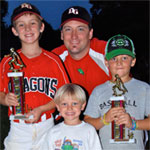Fielding Fundamentals
Major leaguers make fielding ground balls look effortless. They never seem to get a bad hop. Field every ball cleanly. Every throw is perfect. In actuality, it is years of experience that enable them to do this. Of all the essential skills in baseball, this is probably the easiest to learn because it does not require rotating with an object in our hands, whether it be a ball or a bat. What it does require, at times, is guts and being able to get in front of the ball.
There are several things that all great fielders do that allow them to have success fielding the ball. First, they have a great first step. This requires the fielder to get into a proper “ready” position to start. This is basically being in an athletic position and not back on your heels or flat-footed. Second, they are able to get their bodies in the proper fielding position and under control when they get to the ball; feet spread, butt down, head up, hands out front. Third, they possess great timing.
Yes, the fields they play on are incredibly smooth. But, the reason they make it look so effortless is they are able to “read” the ball as it comes to them. That is, watching the hops and being able to pick the best hop when the ball is on the way to them. That can be coming in to get the short hop or moving back to get the big hop, a learned trait none-the-less.
Fielding Progressions:
- Proper ready position
- Hands off knees.
- Athletic stance.
- Creep step
- For righties it’s, “Right, left or right, left, hop.” For lefties, it’s the opposite, “Left, right or left, right, hop.”
- The timing with either one is when the ball is crossing the plate, both feet are down and fielder is in an athletic stance.
- Charge the ball or “read” the ball and determine best hop to get.
- Pro Tip: Regardless of whether you read the ball properly to determine the best hop and get it or not, make sure you are under control when you get to the ball.
- That is, as you are going down to field the ball you have your feet underneath you and you are not moving too fast (still charging hard).
- Approaching the ball
- As you are coming to field the ball, gain control of your speed and get your feet underneath you.
- Your last two steps (for a right hander, opposite for left handers) are right, left, then get down in fielding stance to field the ball.
- Fielding stance
- Feet spread further than shoulder width.
- Knees inside feet.
- Toes pointing straight ahead.
- Butt down, back straight.
- Glove pointing toward the ground, fingers spread.
- Throwing hand palm up and above (or slightly off center to the right for righties) the glove.
- Head up.
- Field the ball in the middle of your body (or slightly off center to the glove side).
- Pay attention to the hop and work your glove from the ground up.
- Getting into throwing position after ground ball is fielded
- After you receive the grounder, secure ball with throwing hand immediately.
- With both hands on ball in glove, hands will come up to chest.
- As hands are coming up to chest, throwing side foot will come forward (to target) and “Replace” glove side foot that will step to target getting body aligned to your target.
- As you are getting aligned to target, hands will break (palms facing away from each other).
- When glove side foot lands, you should be in proper throwing position (front foot/hip/shoulder pointing at target, hands spread with palms facing away from each other, equal bend in arms with upper arms parallel to the ground and in line with target).
- Throwing
- Glove side leads the way.
- Ball does not come forward before front foot lands.
- For longer throws or if you have more time, take an extra shuffle step toward target.
- During practice, always make sure infielder is taking an extra step or two toward the target after the throw.
Baseball Zone’s Memberships give you access to more information on the fundamentals of hitting, troubleshooting hitter problems as well as tons of information on pitching, defense and training.
Baseball Zone’s Practice Planner makes creating practice plans quick and easy. With over a hundred different drills to choose from, creating a well thought out plan is only a few clicks away.

